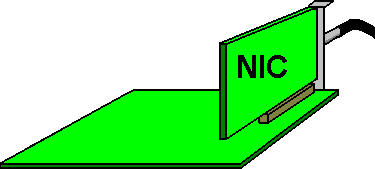The OSI Physical Layer
By Stephen Bucaro
The Physical layer (OSI layer 1) deals with the mechanical and electrical
specifications of the network hardware. Layer 1 specifications define connectors,
pin-outs, signal voltages, and related software.

The most common Physical layer component is the Network Interface Card (NIC). To
install a NIC you need to assign computer resources such as an IRQ and I/O address.
If the operating system and NIC are Plug-and-Play (PnP), these resources will be
assigned automatically.
NIC MACs
Each computer connects to the network utilizing a network interface card (NIC) that
may be installed in an expansion slot inside the computer, or the NIC electronics may
be integrated into the computers motherboard. Each NIC has a unique identifying number
called a media access control (MAC) address. No two NICs ever have the same MAC
address. The MAC address is 48 bits, allowing more than 281 trillion possible unique
addresses.

Computer networks break the data transmitted over the network into small pieces
called packets. Dividing a large document into small packets for transmission allows
computers to share the network cable, rather than having one large transmission
prevent other computers from using it. If an error occurs during transmission, only
the damages packet needs to be retransmitted, rather than the entire large document.
IEEE 802.3 - Ethernet
In 1973 Xerox invented Ethernet to solve the problem of transferring data between
computers. Digital Equipment and Intel collaborated with Xerox in 1973 to publish the
DIX networking standard. In the early 1980s Xerox turned over control of the Standard
to the Institute of Electrical and Electronics Engineers (IEEE). The IEEE sets up
committees to define industry standards. The IEEE 802 committee sets the standards
for networking. The IEEE subcommittee 802.3 sets the standard for Ethernet.
| 
